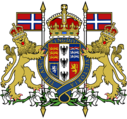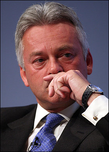Prime Minister of Victoria
| Prime Minister of the Kingdom of Victoria and the Victorian Empire | ||

| ||
| Arms of Her Majesty's Government | ||

| ||
| Last holder | ||
| Guido Zambelis | ||
| until 29.XII.1583 AN
| ||
| Style | The Right Honourable | |
| Residence | 11 Carnegie Street | |
| Appointer | Monarch of Victoria | |
| Term | Confidence of the House of Lords | |
| Inaugural holder | Otto Svenstadt | |
| Formation | 1450 AN | |
| Victorian Empire | |

| |
| This article is part of the series: | |
| Politics and government of the Victorian Empire | |
|
Government
legislature
Foreign policy
| |
The Prime Minister of the Kingdom of Victoria and the Victorian Empire was the political leader of Victoria and her Empire and the Head of Her Majesty's Government. The Prime Minister and Privy Council (consisting of all Secretaries of State, who are government department heads) were collectively accountable for their policies and actions to the Sovereign, the House of Lords, and to the citizens of the Victorian Empire. The final Prime Minister, Guido Zambelis, was appointed on 6.VIII.1569 AN.
Authority
Position
Office of The Prime Minister
Precedence, privileges and form of address
By tradition, before a new Prime Minister could enter 11 Carnegie Street for the first time as its occupant, they were required to announce to the Empire that they have bathed on the shores of Amundsen Bay, the place where Victoria I and her entourage landed on Micras for the first time. This was usually done by saying words to the effect of:
"Her Majesty the Queen has commanded that I bathe on the shores of Amundsen Bay, become First Lord and form a government. I have accepted."
The Prime Minister was made a Privy Counsellor as a result of taking office and thus entitled to the appellation "The Right Honourable". Membership of the Council was retained only for as long as he holds the position of Prime Minister. It was the prerogative of Her Majesty to allow former Prime Ministers to continue in the Privy Council should it have pleased her to do so.
While in office, the Prime Minister officially resided at 11 Carnegie Street in Riego and was also entitled to use the country house of White Cottage in Middleton.
Upon retirement, the Sovereign may have granted a Prime Minister some honour or dignity. The honour commonly, but not invariably, bestowed was membership of the Kingdom's most senior order of chivalry, the Order of Saint Andrew. The practice of creating retired Prime Ministers Knights of the Saint Andrew was fairly sparse. Out of the 27 Prime Ministers between 1450 and 1583, only 8 had been created Knights. The first being Sir Alasdair MacKenzie in 1482 and the last Sir Jack Beatie in 1568. On the retirement of a Prime Minister who was Valencian, it was likely that the primarily Valencian honour of the Order of the Valencian Star would have been used instead of the Order of Saint Andrew, which was generally regarded as a Victorian honour.
As Prime Ministers were appointed from the House of Lords and as such were already Dukes of the Realm, no peerages were given to a Prime Minister for the office he held.
The official title of a Prime Minister was First Lord of The Realm and Prime Minister of the Kingdom of Victoria and the Victorian Empire. This dates back to 1569 when the House of Lords was formed in Victoria. Membership of the House of Lords was a prerequisite to holding the Office of Prime Minister, hence the former title of First Lord of the Realm.
See also
- First Minister of Victoria, the analogous position in Craitish-ruled Victoria
- 11 Carnegie Street
External links
| |||||||||||||||||||
